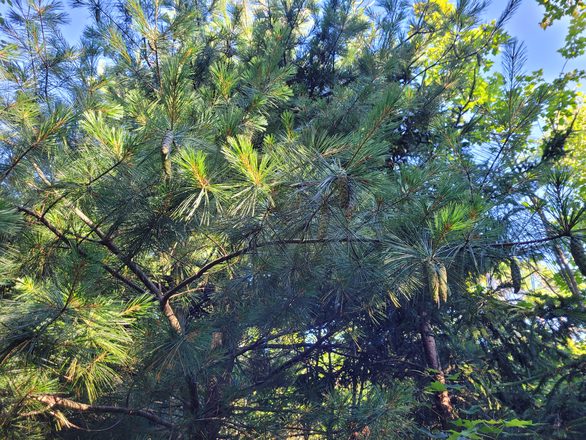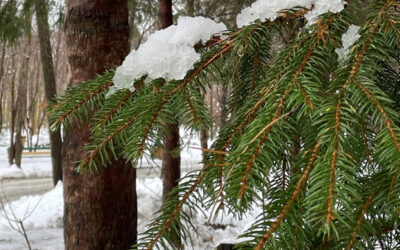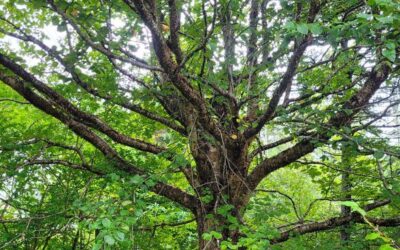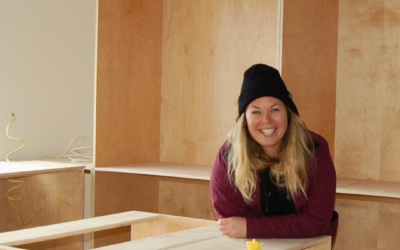Discover the Wabanaki-Acadian Forest with Thriving Forests
Spotlight on the Eastern White Pine – Pinus strobus – guow

Through Thriving Forests, a program dedicated to understanding the ecological importance of Nova Scotia’s Wabanaki-Acadian Forest, we’re shining a spotlight on the Eastern white pine this month.
Uses of Eastern white pines
Eastern white pines are commonly chosen as Christmas trees, and their branches are used in wreath making. When grown in full sun, they have a bushy appearance that requires pruning to achieve the traditional Christmas tree shape.
The wood from white pine is relatively knot free and is often used for window and door trim in houses. While it is less favored for flooring and furniture due to its softness and tendency to cup, in the past it was used for flooring, timber framing and ship masts.
Identifying Eastern white pine
Eastern white pine is one of the largest trees in eastern North America, reaching heights up to 30 metres with trunks up to 100 cm in diameter. Some specimens have thrived for as long as 450 years, surpassing the growth of surrounding forest. Their size makes them ideal nesting sites for large birds like bald eagles.
White pine trees are easily identifiable as the only native pine tree with needles arranged in bundles of five. Red and jack pines, which are also native, have needles form in bundles of two. Among our native coniferous species, white pine is expected to fare best amidst climate changes, making it an ideal species to plant for our program.
Identifying Eastern white pine seeds

Eastern white pine produces slender seeds within cones. These cones, which hang from branches in clusters, are 8-20 cm in length. Mature cones transition from greenish-yellow to a golden or light brown hue when ripe.
The cones consist of 50-80 tightly overlapping scales in rows, enclosing seeds beneath each scale. As the cones begin to open and reach ripeness, the seeds are released on a wing, measuring 20 mm in length. These seeds have a flecked brown seed coat, measuring 5-7 mm in length.

How to harvest seeds
When collecting cones, cut one in half to inspect the interior where the seeds are located. A healthy cone will contain 8-12 viable seeds visible in its half section. It is important to perform a seed count via cut test to gauge the quantity of healthy seeds per cone. Healthy seeds have a firm, white-yellow embryo that fills the seed cavity.
Additionally, make sure you have permission to gather seeds from the area you’re visiting and create an identification tag with information about the species, tree location, GPS coordinates and date.
To join our network of tree monitors or if you know a stand of trees in your community that you would like to direct us to, please reach out via thrivingforests@cleanfoundation.ca.
If you are interested in learning more about Thriving Forests program, click below.
Energy Advisor Trainee Spotlight: Graham Cromwell
Graham Cromwell, from Weymouth Falls, Nova Scotia, graduated with a degree in Kinesiology but felt he needed a change in his career trajectory. This led him to the Energy Advisor Training Program, administered by Clean Foundation, which he graduated from last spring....
Energy Advisor Trainee Spotlight: Salani Khutjwe
Originally from Botswana, Salani Khutjwe’s career began as a biology teacher in his home country. However, his longing for a change led him towards a new path where he could channel his passion for science and education in a different way—one that would allow him to...
Spotlight on red spruce
Discover the Wabanaki-Acadian Forest with Thriving Forests Spotlight on the red spruce – Picea rubens - gawatgw Through Thriving Forests, a program dedicated to understanding the ecological importance of Wabanaki-Acadian Forest in Nova Scotia, we’re shining a...
The Importance of Climate Change Education
Climate change education is crucial, especially for youth facing the accelerating realities of climate change impacts. According to a recent Lancet study, young people are experiencing emotions such as sadness, anxiety and anger in response to climate change. The...
Energy efficiency misconceptions and solutions in Nova Scotia and PEI
Since 2007, Clean Foundation has been doing Home Energy Assessments in Nova Scotia helping homeowners across the province understand how to heat their homes more efficiently and save money through smart energy upgrades. More recently, we’ve started offering the same...
Spotlight on Yellow Birch
Discover the Wabanaki-Acadian Forest with Thriving Forests Spotlight on Yellow birch - Betula alleghaniensis – mnnoqon Through Thriving Forests program, we will delve into the Wabanaki-Acadian Forest by spotlighting various tree species each month to understand the...
How to keep your home cool in the summer heat
While we all look forward to the warm summer months, the same sun that makes for a fun day at the beach or lake can also make our homes uncomfortable. To find out which home cooling tips and techniques are the most effective for our homes, we asked the experts from...
Custom Employment Support Training Bursary – Beneficiary Spotlight: Anne Gilbert
Meet Anne Gilbert, a Nova Scotian with a dream of making a difference in the clean energy sector. Thanks to the Custom Employment Support Bursary, Anne was able to fund her training and certification necessary to take her career to the next level. Today, she's...








Recent Comments